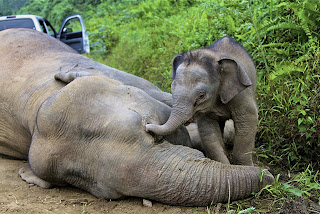A new study examines the
decline of the Sumatran rhino in Borneo. It concludes that the remnant
populations of Sumatran rhinos can only be rescued by combining efforts of
total protection with stimulation of breeding activity. The researchers suggest
to resettle small isolated populations and to undertake measures to improve
fertility. The case of the recently captured female rhino in Kalimantan, Borneo
shows the importance of immediate action. Forschungsverbund Berlin e.V. (FVB)
The Sumatran rhinoceros, also known as hairy rhinoceros or Asian two-horned rhinoceros (Dicerorhinus sumatrensis), is a rare member of the family Rhinocerotidae and one of five extant rhinoceroses. It is the only extant species of the genus Dicerorhinus. It is the smallest rhinoceros, although it is still a large mammal. This rhino stands 112–145 cm high at the shoulder, with a head-and-body length of 2.36–3.18 m and a tail of 35–70 cm. The weight is reported to range from 500 to 1,000 kg , averaging 700–800 kg, although there is a single record of a 2,000 kg specimen. Like both African species, it has two horns; the larger is the nasal horn, typically 15–25 cm, while the other horn is typically a stub. A coat of reddish-brown hair covers most of the Sumatran rhino's body.
Members of the species once inhabited rainforests, swamps, and cloud forests in India, Bhutan, Bangladesh, Myanmar, Laos, Thailand, Malaysia, Indonesia, and China. In historical times, they lived in southwest China, particularly in Sichuan. They are now critically endangered, with only six substantial populations in the wild: four on Sumatra, one on Borneo, and one in the Malay Peninsula. Their numbers are difficult to determine because they are solitary animals that are widely scattered across their range, but they are estimated to number fewer than 100. Survival of the Peninsular Malaysia population is in doubt, and one of the Sumatran populations may already be extinct. Total numbers today may be as low as 80. In 2015, researchers announced that the Eastern Sumatran rhinoceros is extinct from north part of Borneo (Sabah, Malaysia).
A new study examines the
decline of the Sumatran rhino in Borneo. It concludes that the remnant
populations of Sumatran rhinos can only be rescued by combining efforts of
total protection with stimulation of breeding activity. The researchers suggest
to resettle small isolated populations and to undertake measures to improve
fertility. The case of the recently captured female rhino in Kalimantan, Borneo
shows the importance of immediate action. The article has been published in the
scientific journal Global Ecology and Conservation.
A consortium of international
scientists examined the historical development of the Sumatran rhinos in
Borneo. Their study identified the low reproduction of females in combination
with hunting as the main cause for the current decline of rhinos. "Females
do not find a mating partner within the small isolated populations any
more," explains Petra Kretzschmar, scientist at the Leibniz Institute for
Zoo and Wildlife Research (IZW), "the long non-reproductive periods lead
to the development of reproductive tract tumours." Only a combination of
intensive protection with improvements of the reproductive performance can save
the species from extiction. The researchers recommend resettling populations of
less than 15 individuals to highly protected areas. Here, reproductive health
should be monitored on a regular basis and individual female fertility
(conception) should be optimised by using assisted reproduction techniques.
For their study, the
scientists compared historical data with recent developments about the Borneo
rhino (Dicerorhinus sumatrensis harrissoni), one of two extant
subspecies of the Sumatran rhino. The researchers used mathematical models to
reconstruct the decline of the rhino population in the Tabin Wildlife Reserve
(TWR) in the Malayan state Sabah of Borneo. A study on habitat use completed
the picture. Here, the scientists analysed data collected over a span of 13
years and identified the characteristics describing the preferred habitat of
the rhinos.
Today, only two subspecies of
the Sumatran rhino exist, D. s. sumatrensis in Sumatra, Indonesia, and D.
s. harrissoni, in Borneo in the states of Sabah, Malaysia, and Kalimantan,
Indonesia.
Currently, there are still around 100 individuals in Sumatra but the
Sumatran rhino on Borneo is nearly extinct.
The decline of the rhino population
in Sabah has been documented in detail for the first time in this new study.
Many animals were still spotted in 2000. By 2013, the scientists did not
register a single rhino individual left. One of the last Borneo rhinos has been
recently captured in the state of Kalimantan, the southern part of Borneo
belonging to Indonesia. "The captured animal was one of the last females
of its species" says Kretzschmar of the IZW, "it died right after
capture due to an infection of a snare wound."
The reasons for the
catastrophic decline of the Sumatran rhinos have not been previously clear. Data
necessary to improve decisions for conservation management of the rhinos was
missing or fragmentary. The new study closes this gap. It demonstrates that a
combination of techniques can do much to illuminate causes of population
declines, improve decision making for conservation management and possibly
prevent similar developments in populations of other species of similar
ecological standing.
The
catastrophic decline ofmore species of the big area of South East Asia are in the deforestation, palm oil plantations and poachers.

















